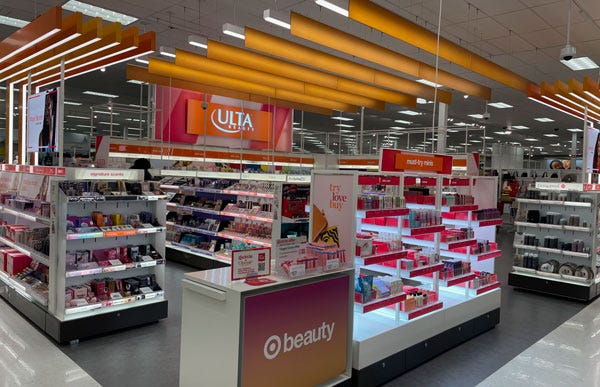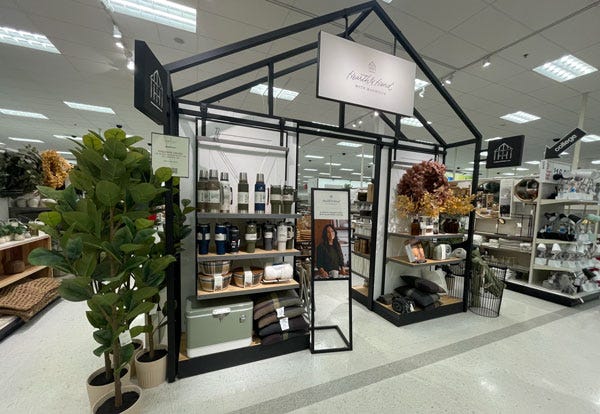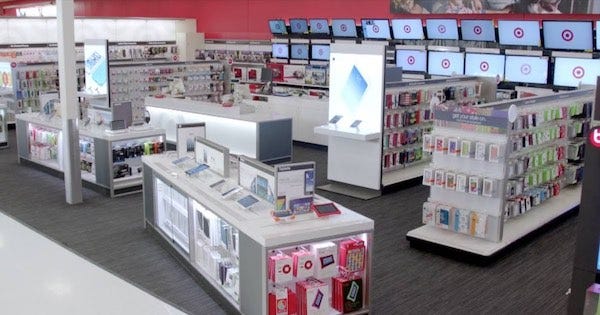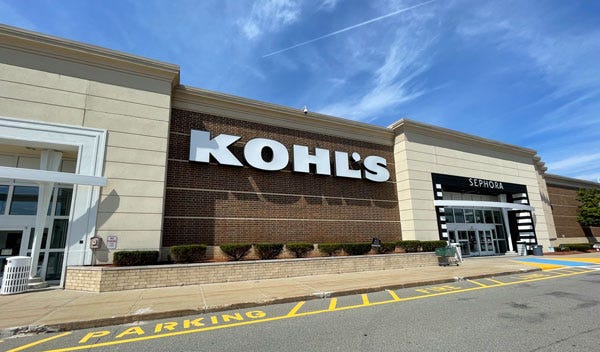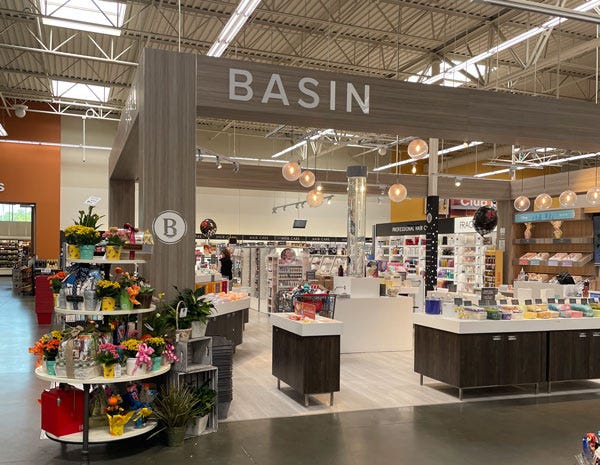The Mall Isn't Dead, It's Just at Target
How stores within a store are transforming big box retailers
Welcome to another edition of Willoughby Hills!
This newsletter explores topics like history, culture, work, urbanism, transportation, travel, agriculture, self-sufficiency, and more.
If you like what you’re reading, you can sign up for a free subscription to have this newsletter delivered to your inbox every Wednesday and Sunday and get my latest podcast episodes:
I was in a Target store recently when a piece from Discourse Magazine written by
came to mind. In it, Del Mastro argues that Wal-Marts are essentially a distillation of small town Main Streets:“That map of the Chapel Hill Walmart resembles a town not only in a land-use sense—its ‘stores’ and ‘streets’—but also in a business sense. Nearly every department—shoes, toys, pharmacy, etc. —represents what would once have been an independent specialized store. More than physical size or market share, this is the real sense in which Walmart has consolidated economic power.”
As I walked around my local Target, I could see Del Mastro’s point. But I also sensed something different. While Wal-Mart and Target were once nearly identical shopping experiences, save for some decorative flourishes, Target has been evolving into something else over the last two decades. In my mind, my local Target is starting to resemble a shopping mall.
The first Target store opened in 1962 outside of Minneapolis, a discount adaptation of the Dayton’s department store chain. Target was deliberately designed to provide a different experience than a traditional department store. The early vision for the store according to president Douglas J. Dayton was a place that would:
“‘…combine the best of the fashion world with the best of the discount world, a quality store with quality merchandise at discount prices, and a discount supermarket...75 departments in all.’”
The shift that I’ve started to notice in recent years is a move away from individual departments and into branded “stores within a store.” This first started at Target in 1999 with the introduction of Starbucks branded cafes to the front of stores.
While the decor is meant to resemble a standalone Starbucks and the menu is familiar, this is technically not a traditional Starbucks cafe. The locations are run by Target and are staffed by Target employees. This means the people making drinks at Target are not eligible for any of the benefits afforded to Starbucks employees, including health care coverage and tipped wages.
Like Starbucks, which is now ubiquitous in Target stores, there is another store whose branding is present at nearly every Target and also appears at the store’s periphery: CVS Pharmacy.
In 2015, CVS acquired Target’s pharmacy business and began to rebrand the pharmacy departments in the stores as CVS Pharmacy. Unlike Starbucks though, the pharmacists working behind the counter are actually employees of CVS and follow CVS store policies.
The motivation for selling the pharmacy business to CVS was in part about allowing Target to focus on its core business and an effort to reshape the look of the stores. When current CEO Brian Cornell arrived in 2014, he expressed a desire for a different shopping experience, as quoted in this piece from Retail Dive in 2016:
“‘We realized we were making [our shoppers] work too hard,’ Cornell said in October at Women’s Wear Daily’s Apparel and Retail CEO Summit in New York. ‘We could deliver great print ads, amazing 30-second spots, but when you went to stores and started browsing or went to target.com, all you saw was a sea of racks or a string of search results. We owed our guests a better presentation.’”
That better presentation has meant, in part, devoting increasing floor space to other brands. At the front corner of my local Target store, directly across from the registers, is an Ulta Beauty branded store within a store.
The department uses different fixtures and different lighting than the rest of the store. It’s meant to feel like a standalone shop. But Ulta is not staffed by a specialized salesperson with product knowledge. It is self service, just like the rest of Target.
Moving into the home goods area, there is another store within a store, this one branded as “Hearth & Hand with Magnolia” and selling products supposedly approved by HGTV sensations Chip and Joanna Gaines. It even has its own “entry door” under a separate “roof.”
Another store within a store at many Target locations is a Disney branded experience. In the 1980s, Disney made a big push into the mall space with the launch of The Disney Store, a standalone store meant to extend the Disney brand outside of the theme parks into local communities. The retail chain is nearly entirely gone now, closing all but a handful of stores over the last several years. However, the Disney Store lives on in Target.

In a presentation at the D23 Expo in 2019, Disney’s then CEO Bob Chapek appeared on stage with Target CEO Brian Cornell and Bullseye the Target mascot to announce the partnership. Disney stores are in many, but not all, Target stores (I do not have one near me).

While not technically a store within a store, the one last area of Target that I think merits mentioning as part of this discussion is the evolution of the electronics department. At one time, that section of the store was quite similar to any other department, save for the merchandise being sold. Here’s a more modern electronics section:
The influence of mall staple the Apple Store is evident, with clean displays featuring working prototypes that can be held and tested.
With the push for multiple stores within a store and the ability to visit several different brands under a single roof, Target is beginning to feel less like a singular experience and more like visiting a mall, where each brand has a separate presence and its own distinct “storefront.”
I’ve written a lot about the store within a store concept, especially as it relates to Toys R Us in both Macy’s stores and within other retailers. It’s not a new idea. Ironically, the person to push the notion of a store within a store the furthest over the last few decades had his roots at Target.
Ron Johnson was a Target executive who was eventually tapped by Steve Jobs to design and run the Apple Store. Johnson was sought out by JC Penney in 2011 to bring transformative change to the ailing retailer.
A large part of Johnson’s strategy hinged on morphing the JC Penney shopping experience from a singular activity to one more akin to a mini trip to the mall. He implemented multiple smaller branded stores within JC Penney, making deals with everybody from Disney to Sephora to bring mini boutiques under the JC Penney roof. The strategy failed miserably and Johnson was fired after 16 months as CEO.
But more than a decade since Johnson’s Penney’s debacle, I wonder if Johnson was really that foolish. Perhaps his timing was bad or JC Penney was just the wrong place to implement his idea, but any rate, the idea of co-branded retail seems to have stuck.
In 2021, Sephora moved into Kohl’s department stores, and the retailer was so confident in the partnership that Sephora signage and branding was added to the exterior of several Kohl’s. Disney moved out of JC Penney and into Target. Speciality soap retailer Basin once only operated in tourist markets like Orlando and Las Vegas. Today, it has dozens of stores within a store in midwest grocery chain Hy-Vee.
By offering these mini boutiques, stores like Target move out of simply utilitarian places to buy products and become places to drink coffee and browse several different “stores” at a time. In other words, a bit like the malls of yesteryear.
One big difference between these stores within a store and a mall is of course that infrastructure can be shared in a big box store that’s not as possible within a mall. Each mall store requires separate staffing, separate register systems, separate storage space.
For the retailer, the store within a store lowers overhead. But it likely results in less jobs and less competition than a mall would have. In a mall, Gap, Limited, and a department store are all competing for workers and shoppers. There’s pressure to offer higher wages to staff and lower prices on the shelf. But when Starbucks, Ulta, Disney, and Target all exist under one roof, that pressure is lower.
Another major difference is that unlike malls, Targets make no pretension of being any sort of public gathering place. While malls were certainly more regulated than a public Main Street and were not usually a place for political canvassing or protest, malls could still house public concerts, photos with Santa, or other community oriented activities. Targets simply don’t have the equivalent of the mall atrium- the focus is on getting in, shopping, and getting out, while hopefully spending more than anticipated.
Perhaps Target as successor to the mall is a bit extreme. Maybe it’s more like a cousin- there’s some shared DNA there, but it’s also quite different in key ways. As enclosed shopping malls across the country continue to close or be redeveloped into other activities like mixed use plazas or Amazon warehouses, it’s interesting to consider what parts of malls will be saved and folded into other stores like Target and which will go extinct over the next several years.
As I wrote relative to Toys R Us, we seem to be at a point where brand names still hold power, even if they don’t have the same ability to stand on their own that they once did.
Thanks for reading Willoughby Hills! Subscribe for free to receive new posts and support my work.
Related Reading
A Cleveland Dead Mall Christmas
If you’ve missed past issues of this newsletter, they are available to read here.







